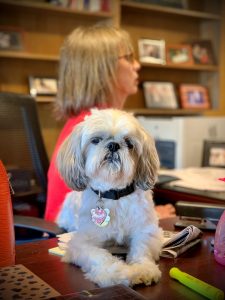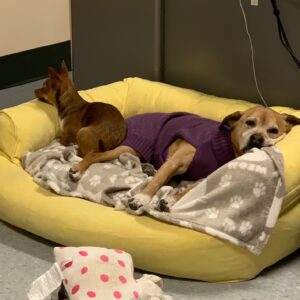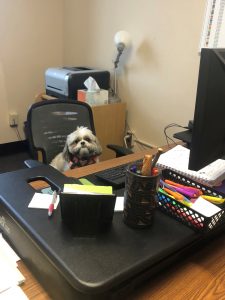-
Adopt
-
Veterinary Care
Services
Client Information
- What to Expect – Angell Boston
- Client Rights and Responsibilities
- Payments / Financial Assistance
- Pharmacy
- Client Policies
- Our Doctors
- Grief Support / Counseling
- Directions and Parking
- Helpful “How-to” Pet Care
Online Payments
Referrals
- Referral Forms/Contact
- Direct Connect
- Referring Veterinarian Portal
- Clinical Articles
- Partners in Care Newsletter
CE, Internships & Alumni Info
CE Seminar Schedule
Emergency: Boston
Emergency: Waltham
Poison Control Hotline
-
Programs & Resources
- Careers
-
Donate Now
Creating a pet-friendly workplace
As the pandemic winds down in the United States, many people will be headed back to the office full time or with a hybrid model. We know that many animals were adopted during the pandemic and many new owners are now starting to adjust to a different schedule.
Thankfully, many pet owners are appropriately taking steps to acclimate their animals to this transition, which will require their pets to be alone more often. If the dog is allowed at work, preparations should be made in advance for a smooth transition.
Things to consider when creating a pet-friendly workplace
How should a dog owner prepare to take their dog to work? What training should be done? Does their dog even want to go to the office, or would they rather spend the day sleeping at home on the couch? How can supervisors and business owners who want to be dog-friendly help keep the peace and make sure everyone’s work gets done?
For many years, the MSPCA-Angell did not allow workplace pets. Usual concerns when considering a pet-friendly workplace included distractions, messes, and what to do in a workplace where not everyone has an office or desk. On top of these, we already have a lot of animals in the buildings and probably have a bit more employees with pets than the average workplace, raising additional concerns.
But, we solicited employee opinions, created a committee, and put in place a policy to make having pets in the office run smoothly.
Why have a pet-friendly workplace?
Reasons for a pet-friendly workplace include:
- Improved mental and physical health. The presence of pets has been shown to reduce blood pressure, anxiety, and stress.
- Increased morale and teamwork. Pets provide a neutral and casual opportunity for employees to connect and bond. They also encourage people from different departments to interact with each other more than they might otherwise.
- More attentive and focused employees. Being able to bring pets into the workplace alleviates the stress and cost of figuring out daycare, dog walkers.
- Attracting potential employees. This can be a benefit to prospective employees, and also help retain existing employees who value it.
How do I start?
We believe it is a good idea to survey employees on their thoughts about a pet-friendly office space. It is important to involve those who will be impacted. Employees could have fears or medical concerns you may not be aware of, for example.
Next, it may make sense to form a committee, consisting of people from a variety of departments and positions, to review responses and determine if there is support for pets at work, and if so, how a policy can be created to address any concerns.
At the MSPCA, we started this as a pilot program to be able to test it out before committing to a permanent policy that people came to rely on.
What should go into a “pets in office” policy?
Below are some areas that your pets in office policy will likely want to address.
- Number of animals: how many animals — and which species — will be allowed per employee?
- Cleanliness: what rules will be needed to ensure that the workplace remains clean?
- Food: The MSPCA policy requires picking up dog food to be sure we don’t attract mice.
- Spaces: determine which spaces should be off limits: the cafeteria, conference room, bathroom, etc.
-
Aggression: Just like people, every dog does not love every other dog, and though office workers may know to be circumspect about their irritation with, even dislike, of a colleague, dogs will not hide their impressions, and may bark or growl at the other dogs in the office. Dogs may also have tendencies toward adopting their owners’ offices as a home territory, and take umbrage at drop-ins by the boss or co-worker; this may be shown by a display of teeth and loud barking as a warning to stay away. See the MSPCA’s policy below for some ideas on how we’ve handled this.
- Anxiety: if your dog barks or howls when they are alone in your home, they may also do that in your office when you leave the room at work. Treat separation-related anxiety before you make your dog an office dog.
- Health concerns: animals should be up-to-date on vaccinations and flea and tick prevention.
- Signs: The MSPCA requires that staff have a sign on their door to indicate there is an animal in the office; see below for our sign.
- Application: Some workplaces have an application to apply for the pets in offices program. This can also be helpful to know how many animals are in the building and where.
-
Spaces within the office: The MSPCA requires that an animal be crated in the office under certain conditions. Note that smaller spaces can create tensions between dogs; think of standing in an elevator vs outside with two colleagues; it is a different feeling entirely.
- Your dog’s office occupation: what will your dog do in the office? Can you develop enough independent activities for your dog to engage in as you work?
- Basic training: your dog should be trained to follow basic commands, such as sit/stay/lie down. “Leave it” is also handy for dropped food.
- Stagger in office: Some workplaces may want to stagger the number of animals who come into the office, due to space or other concerns. One of the things we have noticed is that the dogs who routinely come to work become much better office pets and they settle in easily each day and become accustomed to the routine.
Additional Resources:
MSPCA-Angell’s pet in offices policy (below)
MSPCA Pets in Offices Form
MSPCA-ANGELL
PETS IN THE WORKPLACE IN BOSTON
INTRODUCTION
The MSPCA-Angell recognizes that many of our employees in our Boston facility are devoted and dedicated pet owners. We are privileged to be able to bring our pets to work. The safety and comfort of all of our employees is of utmost importance. Therefore following the provisions of this policy will help to ensure we are able to maintain this wonderful benefit.
The following policy is designed to accommodate the needs of employees and the Society, while understanding that MSPCA-Angell/Boston is a diverse workplace, and our primary responsibility is to our mission and to carry out the work of the organization.
PET COMMITTEE
The Boston Pet Committee consists of employees to provide representation across the organization to help implement this policy, respond to feedback, re-visit the policy and assist with enforcement.
The Pet Committee in Boston is currently comprised of:
ENFORCEMENT AND ROLE OF PET COMMITTEE
While the on-going enforcement of this policy is the responsibility of every member of management, the Pet Committee will look into and take action on specific complaints that are not clear cut. Complaints or questions can be emailed to BostonPetCommittee [at] www.mspca.org. If a person wishes to make an anonymous complaint, a note can be left in Human Resources’ mailbox on the second floor. Every manager is responsible for enforcing this policy with their employees. If the Pet Committee is notified and finds that an employee has violated, or enabled his or her pet to violate this policy they will send a notification to the employee from the Pet Committee, which will be copied to Human Resources and the employee’s supervisor. If necessary, the employee’s manager/supervisor will issue a warning for minor infractions. However, after the third infraction, the privilege of allowing a pet in the office will be revoked. For a severe offense, including, but not limited to, bringing an aggressive or disruptive animal into an office, the privilege of bringing that animal, or any animal, into the workplace may be immediately revoked.
CONDITIONS UPON USE OF OFFICE SPACE
This is the portion of the policy that everyone should read and be very familiar with. All managers should be prepared to enforce this part of the policy with their employees.
An animal will be allowed to be kept in a suitable private or shared office in non-public areas with the approval of the department head or equivalent or his or her designee.
Generally, everyone should be respectful that the MSPCA-Angell is a work environment. The use of office space is a privilege, and effort should be made to ensure that any animal allowed in an office under this policy should not interfere with the owner’s work or that of any co-workers.
- A sign (which can be downloaded on the intranet) shall be placed on the office door. If the sign is designated “red” your pet must be in a crate or on a leash that you are holding at all times while on the property, including their time in your office when alone. Signs need to be current and not left up when the animal is not in the office.
- Dogs must be leashed when in hallways and outside (except in fenced-in areas).
- Animals are not allowed in the cafeteria on the second floor, bathrooms, lobby break room, or conference rooms.
- Animals must not be reactive, aggressive, or bark/make noise repetitively. This applies to animals who might be in an office even for a short time or are being trained.
- Dogs who may present a threat to anyone entering an office must be kept in a crate whether you are in your office or not.
- Dogs must be under the verbal and physical control of their owners at all times (physical control can include crating or on a leash).
- Animals must be up-to-date on vaccinations and without fleas.
- Animals must be housebroken and not destructive.
- Dogs should be walked only on breaks.
- Animals must be secured so they cannot escape.
- Employees in shared private offices must consult with officemates about in-office boarding
- Food must be immediately removed at the end of the animal’s visit.
- Supplies (beds, bowls, leashes, blankets, towels, food, etc.) are to be provided by the employee and should not be taken from the hospital or adoption center (unless the animal is being fostered and the adoption center provides supplies).
- Employees are responsible for keeping offices clean, whether the animal is owned by the employee or a foster animal. Employees should routinely vacuum, clean up litter, and immediately clean up any urine or poop accidents. The MSPCA maintenance department should NOT be called upon to do this cleaning; however, you may request the vacuum or rug cleaner for YOU to use, if needed.
There should be no trace that an animal has been in the office! Please be mindful that not everyone enjoys being with your pet the way you do and this is a work environment. If you see a colleague’s dog behave in any way that is concerning to you or frightens you, please speak to your supervisor.
There may be provisions that supervisors, at their own discretion, may wish to add to the above conditions.
OFFICE SPACE COLLABORATION
Employees without a suitable shared or private office may collaborate with an employee who does have such an office to be able to have his or her pet in an office under this policy. In such an event, both employees are responsible for ensuring compliance with the “Conditions Upon Use of Office Space” above.








